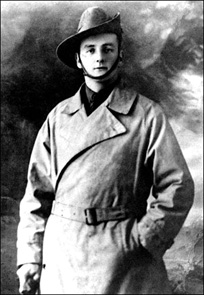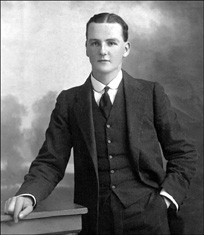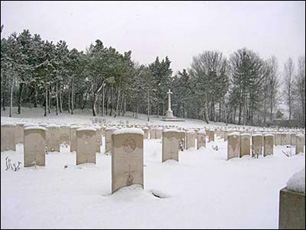 |
Shown below is the article that appears on the Resource Centre at our local library's web site, the article was written by Rhonda Bartle, and for this we thank her very much - the story of Ralph and all the soldiers who lost their lives was a eye opener both for her, as it was for me. There is also a link to the audio version of the article that Rhonda did on our local radio station (mp3 format)
Peter Kivell |
 |
| I died in Hell, (they called it Passchendaele): my wound was slight, and I was hobbling back; and then a shell burst slick upon the duckboards; so I fell into the bottomless mud, and lost the light. |
 |
Siegfried Sassoon
 War is hell, but nothing could prepare the soldiers of WWI for the horrors of Passchendaele. Every nation involved suffered.The British Allied forces alone lost 300,000 men, including 36,500 Australians of which at least one was from Taranaki, New Zealand.Ralph Dorchel Doughty, born 1 October, 1891, signed up for duty in Sydney, just a few days after war was declared. Aged 22, the eighth and youngest child of William and Susanna Doughty of Stratford, he had travelled to Australia in 1913 to seek his fortune. His regimental number, 193, shows how keen he was to enlist.
As a bombardier in the 1st Australian Artillery Division, Ralph saw action at Gallipoli and France, where he was mentioned in dispatches and awarded the Military Cross for 'Conspicuous Gallantry and Devotion to Duty'.
When he entered the fighting at Passchendaele it was as Lieutenant.
War is hell, but nothing could prepare the soldiers of WWI for the horrors of Passchendaele. Every nation involved suffered.The British Allied forces alone lost 300,000 men, including 36,500 Australians of which at least one was from Taranaki, New Zealand.Ralph Dorchel Doughty, born 1 October, 1891, signed up for duty in Sydney, just a few days after war was declared. Aged 22, the eighth and youngest child of William and Susanna Doughty of Stratford, he had travelled to Australia in 1913 to seek his fortune. His regimental number, 193, shows how keen he was to enlist.
As a bombardier in the 1st Australian Artillery Division, Ralph saw action at Gallipoli and France, where he was mentioned in dispatches and awarded the Military Cross for 'Conspicuous Gallantry and Devotion to Duty'.
When he entered the fighting at Passchendaele it was as Lieutenant.
A charnel house
The Battle of Passchendaele, in reality a series of smaller battles that led up to a final showdown, was a desperate attempt to drive through German lines, to move towards the Belgium coast to capture enemy submarine bases there. As British, ANZAC, Canadian and South African soldiers fought with the ImperialGerman Army for control of Passchendaele, a small village close to the town of Ypres in West Flanders, Belgium, it became a charnel house on one of the biggest killing fields of the war. The engagement took place on a boggy piece of land that had seen earlier fighting. Water-logged and swampy even before the constant heavy rain that pounded troops on both sides, the battle arena quickly became a great bowl of stinking, oozing, mud. The mire captured tanks and swallowed soldiers lucky enough to escape the snipers' bullets and flying shrapnel, but unfortunate enough to lose their footing on the duckboards that were meant to provide safe passage across the sludge-filled craters. |
 |
A grey graveyard
What had once been green fields on the edge of the town became a communal grave as the tireless rain soon uncovered the previously buried bodies of men from both camps, until corpses lay around in every stage of decomposition. Rats invaded the trenches, while German sniper fire rained down on any Allied soldier who dared to lift his head. At Passchendaele, the German forces used mustard gas for the first time, and shelling was so incessant that post-battle, aerial photography showed more than a million pocked holes within a one mile (2.56km) radius of ground. The Germans were well entrenched, but after three months of fierce fighting, Passchendaele was finally taken by the Canadian Corps.This so-called victory came at enormous cost, with 500,000 Allied men killed, 90,000 British and Australian bodies unidentified and 42,000 that would never be recovered. Passchendaele will always be remembered as a battlefield too terrible to forget.
The Diaries
Ralph Dorchel Doughty died at Passchendaele on 25 July, 1917, aged 25, from wounds suffered three days earlier: the fighting still had three months to run. Yet his distinctive voice can be heard today because, from the time he first arrived in Alexandria, Egypt, 5 April, 1915, he kept a rigorous diary, at times writing from his gun post in the middle of heavy artillery fire. His is a personal and very personable account of the war. Miraculously, five diaries survived, though a sixth, believed to have been his last, didn't make it home. Because it would have been with Ralph when he was wounded, it was quite possibly lost in the Passchendaele mud. But the story of the diaries themselves, and their subsequent transcription, becomes a different tale of endeavour and commitment. As a boy Peter Kivell had always known he had a relative who died at Passchendaele, and he'd always been fascinated by him. "Ralph's name is listed on the Stratford Hall of Remembrance, in the Stratford Council Chambers. I always stopped off whenever I was driving past. Still do now," he says.
|
 |
A noble website
Sitting at his kitchen table in suburban New Plymouth alongside his father Tony Kivell, with Ralph's diaries displayed in their special non-acidic cardboard sleeves, it's obvious how much both Peter and his father treasure them. Written 92 years ago in indelible pencil that's faded now and almost impossible to read, every page has now been painstakingly and lovingly transcribed and loaded onto a family website to be accessed by anyone who wants to read. You can call it a labour of love, by someone with enough computer savvy to produce an easily navigated website, but Peter says quite humbly, he was just in a position to be able to spend the time doing it. But the website is a credit to him. Incorporated into the general Kivell family history is everything Peter and Tony have learned about Ralph Doughty since they began their concentrated search for details.
Active in the RSA
Tony, a retired bus driver, is active in the RSA as an ex-club committee member and convener in the artefacts committee, as well as on the welfare committee. He and his wife mount medals for war veterans and their families. He begins his own story, which is full of serendipity. "I was given as a young lad Ralph's first diary, a big thick leather-coated one that was held together with copper wire. After my father died, my mother said 'as you have Ralph's first diary, you may as well have the rest of them,' so suddenly there were another three. But I realised there was at least one missing." Years later, Tony was told there was a letter for him waiting in the letter rack at the RSA. Incredibly, a cousin, Ralph Ward, had been to the Ward family reunion and met a lady who had the missing diary. "The Wards are related to us through the Doughtys," Tony says. "Ralph Ward's mother and my grandmother were sisters, so Ralph Doughty is my great uncle, Peter's great-great-uncle. |
 |
A woman called Webster
Tony continues: "The lady's name was Jane Webster, and she was a great-great-niece. When she mentioned the diary, Ralph Ward told her, 'I know someone in New Plymouth with diaries the same'."
He and Peter still feel incredibly lucky to have found the lost diary through a single chance encounter. "Ralph was killed and his diaries came home in a trunk and something got scrambled. We got some, but not that one. Luckily Jane knew what it was and rescued it. Interestingly, Jane, at that time, was in the forces, in the RNZAF at Ohakea airbase where she worked as an engineer. When she came for a visit and suggested she take the diaries away and transcribe them, Tony found it extremely difficult to let them go. Today both he and Peter are more than glad they did.
Through much hard work by Jane and her husband Gary Danvers, the transcriptions offer a vivid account of Ralph Doughty's active service. |
 |
A quest for more
The more Peter and his father learned about Ralph, the more they wanted to know. So began a quest for every available document."We wrote to Australia and got all his personal army papers," Tony says. "We received a mass of them, 95 pieces of paper for $15 Australian, including his medical examination and sign-up papers. "We couldn't help but be impressed. If you write to the New Zealand Army you get one piece of paper. Australia looks after their archives while we tend to let ours slip by.
"The Army Museum at Waiouru, have massive information but they don't hold personal information. That's held at the Personal Office in Wellington."They believe that Ralph's family are somewhat fortunate he signed up in the country he did "Now, you cannot get anything out of New Zealand Archives prior to 1920 unless you have the money to pay for it." |
 |
An emotional involvement
There is no doubt that Ralph enjoyed the thought of going to war. His diary entries reflect the 'Boy's Own Adventure' he felt he had embarked on. Though he often adopts a casual attitude of war, his records gives a clearer view of what the soldiers went through than any documentary. "At the start he was having a lovely time," Peter says. "His diaries show how much he loved it. When he got wounded, he couldn't wait to get back." But what struck Tony and Peter most about their forebear, they say, was Ralph's vivid, often 'non-pc-ness' way of writing. "It's obvious he found it very easy to write. He was a bit of a comedian. He had a confidence about him. He was firing off shells and writing in his diary at the sametime, his hands raw from cordite, writing some more, then firing shells again." Peter openly admits how quickly he became emotionally involved. "A lot of this isn't talked about. You get used to reading it, but you don't get used to it, if you know what I mean."
He chooses a typical entry from the first diary, dated 9th June 1915: |
|
...Our friends woke up again very early this morning. Must have some liver complaint. They have brought another big gun up on the Asiatic side. This one is a 13.5 siege gun firing armour piercing shells. A battleship has just gone over to inquire into things, blazing away from every starboard gun. A big howitzer shell from Ache Baba ricocheted from somewhere handy and lobbed about 12ft away while we were having tea. Fortunately it failed to explode, otherwise it would have been a perfect lesson in aviation for some of us. We went for a swim this afternoon, but they couldn't leave us alone again, one burst right over us and blew out two Frenchmen...Buried in Belgium: When Ralph Doughty died a hero he was interred at the military cemetery Coxyde, Belgium. |
 |
A soldiers grave in Belgium
The quest for information culminated when they received photographs of Ralph's grave in the Coxyde Military Cemetery, Belgium. "The cemetery where he's buried is beautifully maintained, as are all war cemeteries around the world." It's a sad, yet fitting, resting place for a young man who had served two years and 123 days of active service when he died a hero, long before his time, aged 25.
But he is remembered well by the Kivell family, and will continue to inspire others with his valued diary transcriptions.
"The Ministry of Culture and Heritage are putting an item about Ralph on their website," Peter says, "under the Battle of Passchendaele." As a sad footnote, while on holiday in New Plymouth Ralph's mother and father received a telegram requesting their presence in Wellington to receive Ralph's Military Cross. After travelling to the capital, Mrs Doughty suffered a heart attack and died and just like her boy, whom she waved off in 1913, she never made it home again.
|
|

